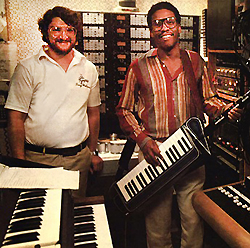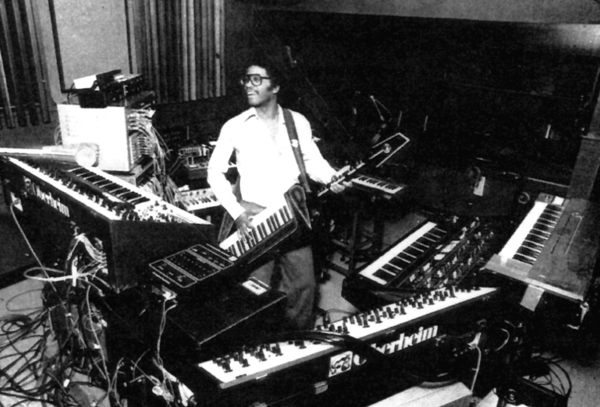
With Hancock, Bell worked as a sound engineer and keyboard technician, as well as production manager, stage manager and truck driver when necessary.
“It was a brutal workload,” he states, but a gig in which he thrived, both professionally and personally, after doing something he swore he’d never do again – he got married.
“We met in 1977 at Herbie’s home,” Bell says, “but I was 24, a rock ‘n’ roll divorcee and I thought, not a chance. Not again. Herbie’s band actually had a pool going on how long we’d last. It ranged from six weeks to 18 months. We’ve been married 38 years now and have three children and a granddaughter, so I won the pool.
“My wife (Margarita) is very traditional but highly independent. She wanted kids and I wanted to rock ‘n’ roll, so I basically outsourced the children to her.” It was a match that allowed him to have his own family but continue to tour and innovate.
During that time Bell built one of the first wireless headset microphones, added a disk drive to a synthesizer and built an automated patch bay – both firsts – and, in 1979, he and others created an integrated, multivendor interface (an analog version of MIDI) to integrate Hancock’s various keyboards.
They later expanded on that system to include a mixing console, tape machine, video deck and multiple keyboards, with an Apple II as the user interface and a 16-bit master computer running a custom built operating system, designed by Bell, to speed up processing.

The concept was to use different manufacturers’ gear in an open architecture – a precursor to the networked business model MIDI later helped foster. “Where multiple companies are invested in the outcome and therefore amplify the whole business,” he adds.
Huge Inspiration
In part, the concept was inspired by a 1976 visit to Xerox Park where Bell and Hancock were introduced to a prototype for a personal computer, well before the Macintosh. “We had to sign a non-disclosure agreement and couldn’t talk about what we’d seen for years, but Dr. Alan Kay, who showed us the computer, was a huge inspiration to me. He said: ‘The easiest way to predict the future is to invent it’ and that was my philosophy about technology and system design. The easiest way to have a reliable sound system and great sounding bands was to build a reliable system and great sounding band gear.”
Bell refers to the mid-70s/early-80s as “the stone knives and bear skin rugs era” of keyboard and audio technology. “We built our own amplifiers. Early wireless technology was cutting edge, but not stable. We used a British Kelsey console for monitors. I built my own direct boxes and front-loaded speaker system to maximize bass response. I replaced every piece of The Headhunters’ sound and band gear except the instruments. We used military grade connectors on multi-cables, shock-mounted every microphone and cut low frequencies by putting 12-inch speakers downstage so the bass player could hear the band without any 40 to 80 cycle stuff on stage at all, and had super clean sounds because everything was properly isolated.”
